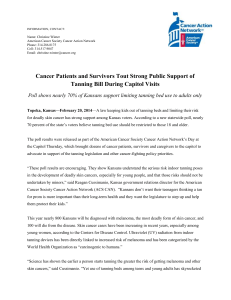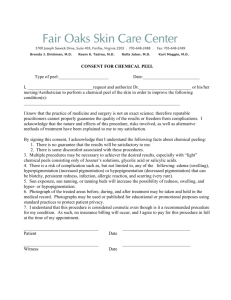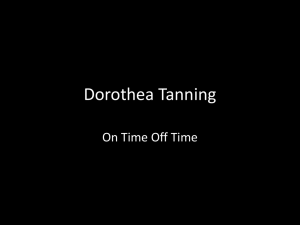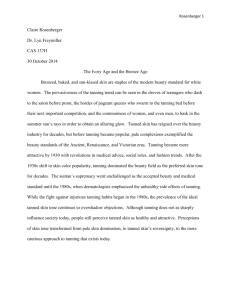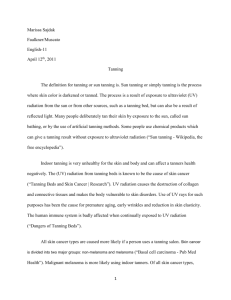Courtney Yealy English 15-87 9 November 2009 A Killer Tan Skin
advertisement
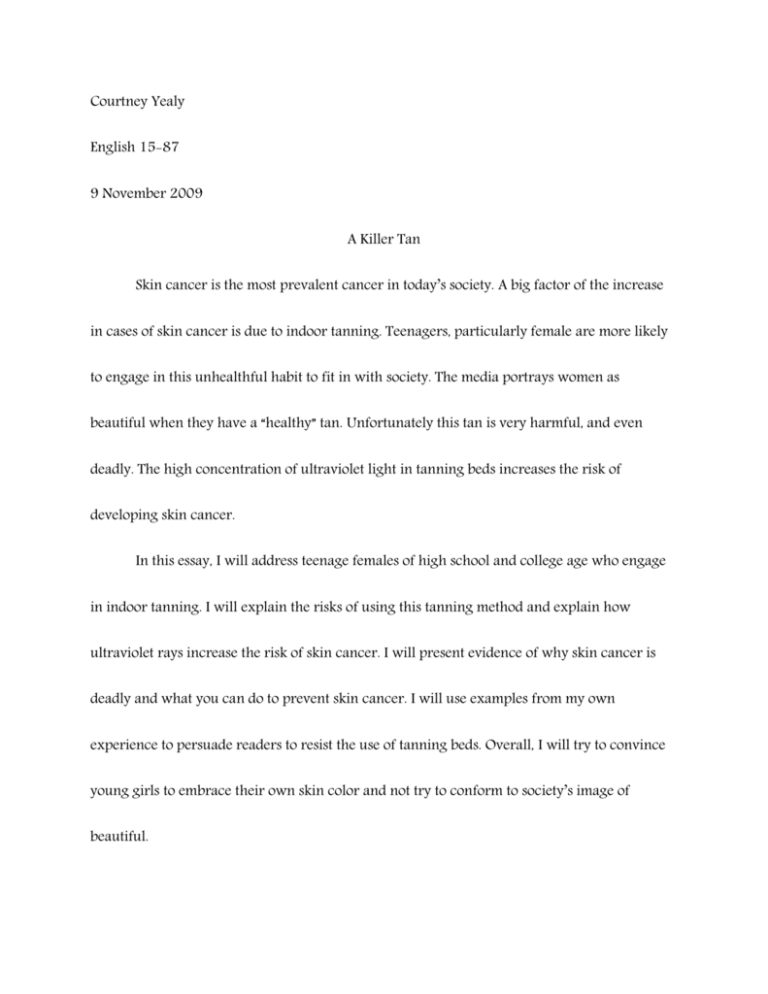
Courtney Yealy English 15-87 9 November 2009 A Killer Tan Skin cancer is the most prevalent cancer in today’s society. A big factor of the increase in cases of skin cancer is due to indoor tanning. Teenagers, particularly female are more likely to engage in this unhealthful habit to fit in with society. The media portrays women as beautiful when they have a “healthy” tan. Unfortunately this tan is very harmful, and even deadly. The high concentration of ultraviolet light in tanning beds increases the risk of developing skin cancer. In this essay, I will address teenage females of high school and college age who engage in indoor tanning. I will explain the risks of using this tanning method and explain how ultraviolet rays increase the risk of skin cancer. I will present evidence of why skin cancer is deadly and what you can do to prevent skin cancer. I will use examples from my own experience to persuade readers to resist the use of tanning beds. Overall, I will try to convince young girls to embrace their own skin color and not try to conform to society’s image of beautiful. Courtney Yealy English 15-87 13 November 2009 A Killer Tan Tanning is all the rage in this generation. Young girls look at models and celebrities in magazines and on TV who have perfectly tanned skin. The media leads people to perceive that a “healthy” tan makes a person more attractive. Young viewers see beautiful adult women sporting a deep summer glow in the middle of winter and viewers wonder, “How do these actresses achieve such nice tans without hours spent in the sun?” Indoor tanning beds provide an efficient and productive means of tanning. After a few tanning sessions, skin tone darkens and you have instantaneously increased your risk of skin cancer. Teenagers, particularly females of high school and college age are at the highest risk of developing the habit of indoor tanning. People uninformed about the tanning technique describe tanning beds as safer because you avoid the sun’s harmful rays, but light emitted from these tanning beds is concentrated ultraviolet light. Don’t let tanning salon owners convince you that their tanning beds are safe simply because they contain more UVA than UVB rays. UVA rays are just as toxic and harmful to your skin as UVB rays, and the idea that indoor tanning is healthy and necessary for Vitamin D absorption is a common misconception [2]. Teenage females who engage in indoor tanning at an early age increase their risk of skin cancer and other harm from this unhealthy habit. Indoor tanning beds have many physical effects on your body. When using a tanning bed, you are exposed to a massive concentration of ultraviolet light, very similar to the sun’s rays. This exposure can cause severe skin burns if your exposure to the light is too great during a short amount of time. The ultraviolet radiation can damage eyesight by harming the lens and cornea of the eye. Additionally, overexposure can lead to early development of cataracts [2]. Tanning can cause age spots and turn your skin very blotchy. Furthermore, the color of your skin may vary with this exposure, often leaving skin tinted orange in color. Along with aging your skin significantly, these UV rays can cause wrinkles, and more importantly can increase your risk of skin cancer. Skin cancer is one of the most prevalent types of cancer in today’s society. Caucasians are most susceptible to developing skin cancer [1] due to the fact that white skin contains less melanin which protects the body from UV rays [4]. Cancers of the skin are classified into two categories, malignant or benign. Malignant tumors are known as melanomas, and benign tumors are classified as basal cell carcinomas or squamous cell carcinomas. Over 85% of skin cancer deaths are due to melanoma [1].When the ultraviolet radiation hits the skin, it can directly damage DNA in the epidermal (skin) cells. The UV rays do this by breaking DNA and causing it to be altered to produce cyclobutane pyrimidine dimers (CPDs) [1]. These genetic mutations in cells lead to skin cancer. The Journal of the National Cancer Institute presented evidence that tanning beds are helping drive up rates of melanoma, which kills one American every hour. The lifetime risk of developing invasive melanoma has increased 2,000 percent since 1930 [3]. According to the National Cancer Institute, in 2009 alone, there were 68,720 new cases of melanoma and 8,650 deaths as a result of melanoma. Melanomas may start as very small formations but can rapidly spread to other parts of the body [1]. Genetics play a role in the risk of developing skin cancer as well. Individuals who have a family history of melanoma or skin cancer are more likely to develop cancer, especially if they are exposed to excessive amounts of ultraviolet radiation [2]. Both of my parents have had skin cancer removed from various parts of their bodies which had been exposed to harmful amounts of ultraviolet light. After seeing both my parents with large scars from having tumors cut out of their skin, I feel that overexposing oneself to tanning is an extremely risky behavior. My father regularly visits the dermatologist to have small carcinomas (cancerous cells) frozen off the surface of his skin before the tiny forming tumors grow into the inner layers of the epidermis and dermis. Unfortunately, many young girls do not understand the serious risks of tanning beds and their relation to skin cancer development. About 25% of American adolescents age 11 to 19 have reported use of indoor tanning [3]. The adolescent girls who report using a tanning bed shockingly claim that, “[I]t was worth getting burned” [4]. Sun damage and photo-aging of the skin is a cumulative process, meaning that damage continues to build up over time [1]. With continued exposure, those who use tanning beds begin aging their skin early in life, even if the results are not immediate. These personal habits formed at a young age drastically increase the chances for developing skin cancer in the future. The media devotes little attention to addressing the risk of skin cancer through use of indoor tanning. There are several television commercials that address the risks of tobacco products and the increased risk of lung cancer, but little is done to make teenagers, particularly females, aware of the deadly risks of skin cancer. Both men and women develop skin cancer, but a recent study on women who tan in tanning salons showed that women who visited a tanning salon at least once as month were at least 55% more likely to develop melanoma than women who did not artificially tan [4]. In addition to these 55%, fair skinned individuals have an even higher risk of developing skin cancer, and well as those who have a lot of moles on their skin [2]. Awareness and prevention are two of the best ways to combat the rapid rise in skin cancer. It is extremely important to take precautions concerning sun exposure. Every person who is exposed to sunlight or any type of ultraviolet rays should take caution to apply sunscreen of at least SPF 30 that protects the skin against UVA and UVB rays. Proper eye protection, such as sunglasses that cover 100% of UVA and UVB rays should be worn as well. Regularly performing self-checks on your body by examining any moles is an effective means to catching any sign of cancerous lesions. At an early stage, skin cancer is nearly 100% treatable [1]. Society presents the image that tan skin is in style. And I ask, who says that pale isn’t pretty? Teenage girls must embrace their own skin color and not try to fit in with what society says is beautiful. The risks of fitting in are far too deadly to be worth the trouble. Being comfortable with your own self image and appearance is an important part of growing up. Having radiant, pale skin is a far better attribute than bearing the permanent scars of removing skin cancer. Citations [1] So Ph.D., Po-Lin. Skin Cancer. The Biology of Cancer. 2008.Chelsea House Publishers, New York, NY. Print. [2] “Familial Melanoma Study News.” Genetic Epidemiology Branch. Spring 2008 <http://dceg.cancer.gov/files/familial_Melanoma_Newsletter.pdfa> [3] Lazovich, DeAnn and Forster, Jean. Indoor tanning by adolescents; prevalence, practices and policies. European Journal of Cancer. 2004 May 10. <http://www.sciencedirect.com/science?_ob=MImg&_imagekey=B6T68-4DPYG2P-41&_cdi=5024&_user=209810&_orig=search&_coverDate=01%2F01%2F2005&_sk=999 589998&view=c&wchp=dGLbVlbzSkWz&md5=68aa247696e6fb0ecded98ec1f3ad932 &ie=/sdarticle.pdf> [4] Alberts, David. Hess, Lisa. Fundamentals of Cancer Prevention. 2005. Springer Berlin Heildelberg, Germany. Print.

